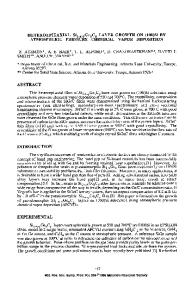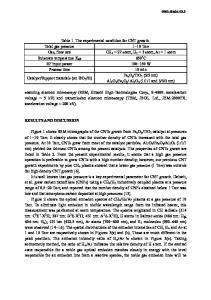Low-Temperature Hetero-Epitaxial Growth of Ge on Si by High Density Plasma Chemical Vapor Deposition
- PDF / 473,043 Bytes
- 7 Pages / 612 x 792 pts (letter) Page_size
- 52 Downloads / 297 Views
0934-I09-02
Low-Temperature Hetero-Epitaxial Growth of Ge on Si by High Density Plasma Chemical Vapor Deposition Malcolm Carroll1, Josephine Sheng2, and Jason C. Verley2 1
Photonic Microsystems Technology, Sandia National Laboratories, P.O. Box 5800, M.S. 1082, Albuquerque, NM, 87185
2
Sandia National Laboratories, Albuquerque, NM, 87185
ABSTRACT Demand for integration of optoelectronic functionality (e.g., optical interconnects) with silicon complementary metal oxide semiconductor (CMOS) technology has for many years motivated the investigation of low temperature (~ 450ºC) germanium deposition processes that may be integrated in to the back-end CMOS process flow. A common challenge to improving the germanium quality is the thermal budget of the in-situ bake, which is used to reduce defect forming oxygen and carbon surface residues [1, 2]. Typical cleaning temperatures to remove significant concentrations of oxygen and carbon have been reported to be approximately 750ºC for thermal hydrogen bakes in standard chemical vapor deposition chambers [3]. Germanium device performance using lower peak in-situ cleans (i.e., ~450°C) has been hampered by additional crystal defectivity, although epitaxy is possible with out complete removal of oxygen and carbon at lower temperatures [4]. Plasma enhanced chemical vapor deposition (PECVD) is used to reduce the processing temperature. Hydrogen plasma assisted in-situ surface preparation of epitaxy has been shown to reduce both carbon and oxygen concentrations and enable epitaxial growth at temperatures as low as ~150°C [5, 6]. The hydrogen is believed to help produce volatile Si-O and H2O species in the removal of oxygen, although typically this is not reported to occur rapidly enough to completely clear the surface of all oxygen until ~550ºC. In this paper, we describe the use of an in-situ argon/germane high density plasma to help initiate germanium epitaxy on silicon using a peak temperature of approximately 460ºC. Germanium is believed to readily break Si-O bonds to form more volatile Ge-O [7-9], therefore, argon/germane plasmas offer the potential to reduce the necessary in-situ clean temperature while obtaining similar results as hydrogen in-situ cleans. To the authors knowledge this report is also the first demonstration of germanium epitaxy on silicon using this commercially available high density plasma chamber configuration instead of, for example, remote or electron cyclotron resonance configurations.
INTRODUCTION Germanium-silicon heterostructures are currently being considered for near infrared (NIR) optoelectronic (e.g., detectors [4], and modulators [10]) that are compatible with the complementary metal oxide semiconductor (CMOS) platform. A common challenge to advancing this technology is minimizing the defects that form in the germanium (Ge) due to the lattice mismatch with the Si substrate. Recently Ge (p)/Si (n) diodes that include the interface in the junction were reported to produce detectors with potentially useful NIR performance despite the defective
Data Loading...










